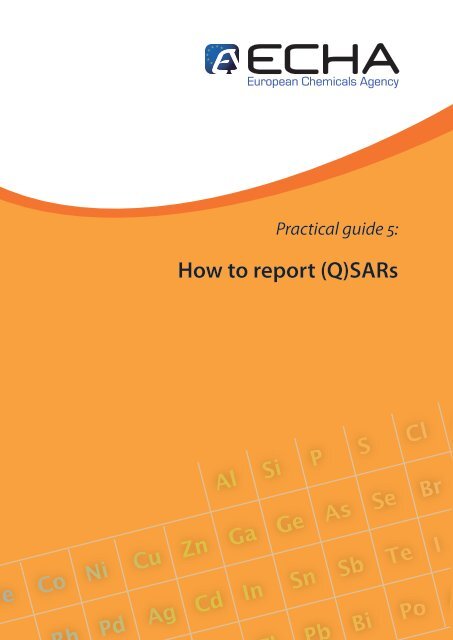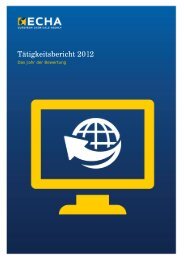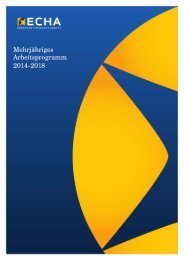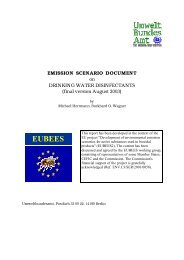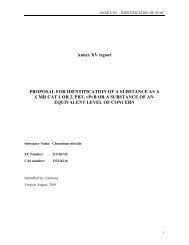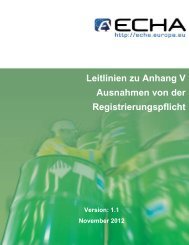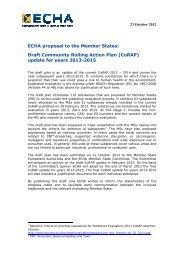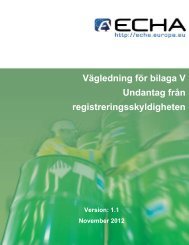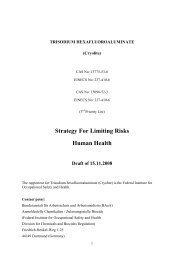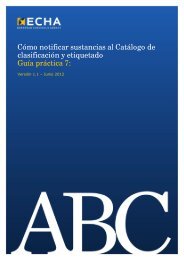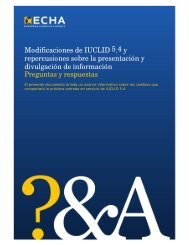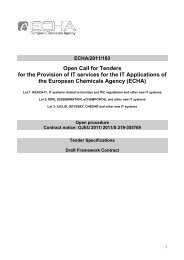Practical Guide 5: How to report (Q)SARs - ECHA - Europa
Practical Guide 5: How to report (Q)SARs - ECHA - Europa
Practical Guide 5: How to report (Q)SARs - ECHA - Europa
Create successful ePaper yourself
Turn your PDF publications into a flip-book with our unique Google optimized e-Paper software.
<strong>Practical</strong> guide 5:<br />
<strong>How</strong> <strong>to</strong> <strong>report</strong> (Q)<strong>SARs</strong>
LEGAL NOTICE<br />
This document contains guidance on REACH explaining the REACH obligations and how <strong>to</strong> fulfil<br />
them. <strong>How</strong>ever, users are reminded that the text of the REACH regulation is the only authentic<br />
legal reference and that the information in this document does not constitute legal advice. The<br />
European Chemicals Agency does not accept any liability with regard <strong>to</strong> the contents of this<br />
document.<br />
<strong>Practical</strong> guide 5: <strong>How</strong> <strong>to</strong> <strong>report</strong> (Q)<strong>SARs</strong><br />
Reference: <strong>ECHA</strong>-10-B-10-EN<br />
ISBN-13: 978-92-9217-004-2<br />
ISSN: 1831-6727<br />
Date: 24/03/2010<br />
Language: EN<br />
© European Chemicals Agency, 2009.<br />
Cover page © European Chemicals Agency<br />
Reproduction is authorised provided the source is fully acknowledged in the form<br />
“Source: European Chemicals Agency, http://echa.europa.eu/”, and provided written<br />
notification is given <strong>to</strong> the <strong>ECHA</strong> Communication Unit (publications@echa.europa.eu).<br />
This document will be available in the following 22 languages:<br />
Bulgarian, Czech, Danish, Dutch, English, Es<strong>to</strong>nian, Finnish, French, German, Greek,<br />
Hungarian, Italian, Latvian, Lithuanian, Maltese, Polish, Portuguese, Romanian,<br />
Slovakian, Slovenian, Spanish and Swedish<br />
If you have questions or comments in relation <strong>to</strong> this document please send them (quote<br />
the reference and issue date) using the information request form. The information<br />
request form can be accessed via the Contact <strong>ECHA</strong> page at:<br />
http://echa.europa.eu/about/contact_en.asp<br />
European Chemicals Agency<br />
Mailing address: P.O. Box 400, FI-00121 Helsinki, Finland<br />
Visiting address: Annankatu 18, Helsinki, Finland
TABLE OF CONTENTS<br />
1. INTRODUCTION .................................................................................................................. 1<br />
2. HOW TO GET STARTED WITH (Q)SARS .......................................................................... 2<br />
2.1. Substance characterisation ..................................................................................................... 2<br />
2.2. (Q)SAR models .......................................................................................................................... 2<br />
2.3. Overall Assessment of adequacy and <strong>report</strong>ing .................................................................... 2<br />
3. QUESTIONS ON HOW TO APPLY AND REPORT (Q)SAR UNDER REACH ................... 4<br />
3.1. Which Guidance documents should I read? .......................................................................... 4<br />
3.2. Is the (Q)SAR model valid? ...................................................................................................... 4<br />
3.3. Does the substance fall within the applicability domain of the (Q)SAR model? ................ 5<br />
3.4. Is the model prediction adequate for the purpose of classification and labelling<br />
and/or risk assessment? .......................................................................................................... 5<br />
3.5. <strong>How</strong> do I <strong>report</strong> a (Q)SAR prediction in IUCLID 5? ................................................................ 6
1. INTRODUCTION<br />
Regulation (EC) No 1907/2006 concerning the Registration, Evaluation, Authorisation<br />
and Restriction of Chemicals (hereafter, REACH) foresees the use of non test methods<br />
such as (Quantitative) Structure-Activity Relationships [(Q)<strong>SARs</strong>], grouping of<br />
substances and read-across for adaptation of the standard testing regimes. More<br />
specifically, Recital 47 of REACH determines the objectives of the Regulation with<br />
respect <strong>to</strong> avoidance of unnecessary testing on vertebrate animals:<br />
“[…] it is necessary <strong>to</strong> replace, reduce or refine testing on vertebrate animals.<br />
Implementation of this Regulation should be based on the use of alternative test<br />
methods, suitable for the assessment of health and environmental hazards of<br />
chemicals, wherever possible. The use of animals should be avoided by recourse <strong>to</strong><br />
alternative methods validated by the Commission or international bodies, or<br />
recognised by the Commission or the Agency as appropriate <strong>to</strong> meet the information<br />
requirements under this Regulation.”<br />
These methods and other data sources have <strong>to</strong> be explored before considering<br />
vertebrate animal testing. This practical guide provides an overview of important aspects<br />
when predicting properties of substances using (Q)SAR models as defined in the<br />
REACH Regulation. More detailed information is available in the Guidance documents<br />
(see 3.1.).<br />
The information given in this practical guide does not describe the requirements <strong>to</strong> pass<br />
the technical completeness check which are illustrated in the Dossier Submission<br />
Manual (No. 05 - <strong>How</strong> <strong>to</strong> complete a technical dossier for registrations and PPORD<br />
notifications).<br />
1
2. HOW TO GET STARTED WITH (Q)SARS<br />
The use of (Q)SAR models with software is rather straightforward. <strong>How</strong>ever, experience<br />
and a thorough understanding of (Q)<strong>SARs</strong> will be needed when it comes <strong>to</strong> the<br />
assessment of whether predictions are reliable and adequate for the purpose of<br />
classification and labelling and/or risk assessment and can thus be used instead of<br />
testing.<br />
2.1. Substance characterisation<br />
The chemical structure needs <strong>to</strong> be well defined, following the Guidance on identification<br />
and naming of substances under REACH. All individual constituents of multi-constituent<br />
substances should be addressed. The composition of the well defined substances has <strong>to</strong><br />
include also known impurities (and additives, if any). For UVCBs, expert judgement is<br />
needed <strong>to</strong> decide whether structures can be identified which are representative for the<br />
substance. In case of a stable transformation product, it should be identified. A suitable<br />
structural representation for the chemical (SMILES, mol file etc.) is usually required.<br />
Stereochemistry should be taken in<strong>to</strong> account if necessary.<br />
2.2. (Q)SAR models<br />
SAR and QSAR models, collectively referred <strong>to</strong> as (Q)<strong>SARs</strong>, are theoretical models that<br />
can be used <strong>to</strong> predict in a quantitative or qualitative manner the physico-chemical,<br />
biological (e.g. a (eco)<strong>to</strong>xicological) and environmental fate properties of compounds<br />
from the knowledge of their chemical structure. A SAR is a qualitative relationship that<br />
relates a (sub)structure <strong>to</strong> the presence or absence of a property or activity of interest. A<br />
QSAR is a mathematical model relating one or more quantitative parameters, which are<br />
derived from the chemical structure, <strong>to</strong> a quantitative measure of a property or activity. In<br />
order <strong>to</strong> predict a property of a chemical, the validity of the selected (Q)SAR model<br />
should be assessed, and it should be verified that the chemical falls within the<br />
applicability domain <strong>to</strong> give a reliable prediction.<br />
2.3. Overall Assessment of adequacy and <strong>report</strong>ing<br />
In order <strong>to</strong> generate a reliable and adequate prediction of the presence or absence of a<br />
chemical’s property <strong>to</strong> fulfil the information requirements under REACH, (i) a (Q)SAR<br />
model should be used whose scientific validity has been established and (ii) the<br />
substance should fall within the applicability domain of the (Q)SAR model, (iii) the<br />
2
prediction should be fit for the regula<strong>to</strong>ry purpose, and (iv) the information should be well<br />
documented. An assessment of the first three points above is expected <strong>to</strong> be included in<br />
the registration dossier if substance properties are predicted using (Q)SAR models. In<br />
case there is not sufficient information <strong>to</strong> address all of them, a prediction could be used<br />
as part of a weight-of-evidence approach or as supporting information. The closer the<br />
outcome is <strong>to</strong> a regula<strong>to</strong>ry decision point (e.g. classification of a substance as hazardous<br />
versus non classification), the more accurate predictions or a more detailed justification<br />
is needed. The consequences of a wrong decision based on predicted properties will<br />
indicate how much uncertainty for the prediction can be accepted.<br />
3
3. QUESTIONS ON HOW TO APPLY AND REPORT<br />
(Q)SAR UNDER REACH<br />
3.1. Which Guidance documents should I read?<br />
A four pages summary on how <strong>to</strong> use non-testing data obtained by applying (Q)<strong>SARs</strong> is<br />
available in the Guidance on information requirements and chemical safety assessment<br />
in:<br />
Chapter R.4: Evaluation of available Information:<br />
R.4.3.2.1 (Q)SAR data<br />
A dedicated part on computational methodologies is available in the Guidance on<br />
information requirements and chemical safety assessment in<br />
Chapter R.6: (Q)<strong>SARs</strong> and grouping of chemicals:<br />
R.6.1 Guidance on (Q)<strong>SARs</strong><br />
Relevant <strong>to</strong>ols and approaches for the endpoint(s) of interest are offered by each<br />
endpoint specific guidance document included in the Guidance on information<br />
requirements and chemical safety assessment in:<br />
Chapter R.7: Endpoint specific Guidance.<br />
Information on the use of non-testing degradation and bioaccumulation data for<br />
persistent, bioaccumulative and <strong>to</strong>xic (PBT) chemicals is accessible from the Guidance<br />
on information requirements and chemical safety assessment in:<br />
3.2. Is the (Q)SAR model valid?<br />
Chapter R.11: PBT Assessment.<br />
The validity of (Q)SAR models for regula<strong>to</strong>ry purposes is characterised and documented<br />
according <strong>to</strong> the five agreed OECD principles, as described in the REACH guidance<br />
R.6.1 Guidance on (Q)<strong>SARs</strong>:<br />
1. The (Q)SAR model should be associated with a defined endpoint.<br />
2. The (Q)SAR model should be expressed in form of an unambiguous algorithm.<br />
3. The (Q)SAR model should be associated with a defined domain of applicability.<br />
4. The (Q)SAR model should be associated with appropriate performance of the<br />
model (the statistical “goodness” of the model, robustness and predictivity).<br />
5. The (Q)SAR model should be associated with a mechanistic interpretation for<br />
human health and eco<strong>to</strong>xicological endpoints, if possible.<br />
4
A reference <strong>to</strong> a well-documented model or a (Q)SAR Model Reporting Form (QMRF),<br />
attached <strong>to</strong> a dossier, will be beneficial for the dossier submitter and is highly<br />
recommended. See the Guidance on information requirements and chemical safety<br />
assessment, Chapter R.6: (Q)<strong>SARs</strong> and grouping of chemicals (R.6.1.9.1) for more<br />
details on how <strong>to</strong> generate in the QMRF. Please note that the JRC (Q)SAR Model<br />
Database (QMDB) is intended <strong>to</strong> provide information on (Q)SAR models submitted <strong>to</strong><br />
JRC for peer review (http://qsardb.jrc.it/qmrf/search_catalogs.jsp).<br />
There is no formal adoption process foreseen for (Q)SAR models; the validity,<br />
applicability and adequacy of (Q)SAR models for regula<strong>to</strong>ry purposes will be assessed<br />
on a case-by-case basis.<br />
NOTE: A valid (Q)SAR model does not necessarily produce a valid prediction. It is<br />
necessary <strong>to</strong> assess whether the substance falls within the applicability domain of the<br />
(Q)SAR model, that the results are adequate for the purpose of classification and<br />
labelling and/or risk assessment, and that adequate and reliable documentation of the<br />
applied method is provided.<br />
3.3. Does the substance fall within the applicability domain of<br />
the (Q)SAR model?<br />
In order <strong>to</strong> get a reliable prediction, it is important <strong>to</strong> verify that the chemical of interest<br />
falls within the applicability domain of the model. The concept of applicability domain<br />
was introduced <strong>to</strong> assess the probability of a chemical being covered by the (Q)SAR<br />
training set and it is connected <strong>to</strong> the reliability of the prediction. The applicability of a<br />
model could, for example, be based on the (sub)structures present in the molecules<br />
and/or a range of molecular descrip<strong>to</strong>r or prediction values. The applicability domain can<br />
also be defined by chemicals (or their metabolites/degradation products) having the<br />
same reaction mechanisms: e.g. types of reactivity or interaction with biomolecules.<br />
Sometimes it is not the chemical itself which reacts with biomolecules but its<br />
metabolites/degradation products. Therefore, it is also important <strong>to</strong> investigate<br />
metabolic/degradation pathways and the reactivity of the metabolites/degradation<br />
products. See the Guidance on information requirements and chemical safety<br />
assessment, Chapter R.6: (Q)<strong>SARs</strong> and grouping of chemicals (R.6.1.5.3) for more<br />
details.<br />
3.4. Is the model prediction adequate for the purpose of<br />
classification and labelling and/or risk assessment?<br />
For a (Q)SAR prediction <strong>to</strong> be adequate, it should be not only reliable, but also relevant<br />
for regula<strong>to</strong>ry decision. The adequacy of the model prediction for the purpose of<br />
5
classification and labelling and/or risk assessment will be very much endpointdependent.<br />
Additional information might be needed <strong>to</strong> assess the generated prediction<br />
for adequacy in the context of a regula<strong>to</strong>ry decision. Therefore, the validity (are the five<br />
OECD principles on scientific validity of a model fulfilled?), applicability (can reliable<br />
predictions be expected if the model is applied <strong>to</strong> the substance of interest?) and<br />
relevance (is the information generated which is needed for the risk assessment and/or<br />
classification and labelling?) needs <strong>to</strong> be assessed for each individual prediction.<br />
Scientifically valid<br />
(Q)SAR model<br />
Reliable (Q)SAR<br />
result<br />
Adequate<br />
(Q)SAR result<br />
(Q)SAR model<br />
relevant for the<br />
regula<strong>to</strong>ry<br />
purpose<br />
6<br />
(Q)SAR model<br />
applicable <strong>to</strong><br />
query chemical<br />
3.5. <strong>How</strong> do I <strong>report</strong> a (Q)SAR prediction in IUCLID 5?<br />
To <strong>report</strong> a (Q)SAR prediction in IUCLID 5, the following information has <strong>to</strong> be provided:<br />
1. Information on the validity of the (Q)SAR model.<br />
2. Verification that the substance falls within the applicability domain of the (Q)SAR<br />
model.<br />
3. Assess the adequacy of the results for the purpose of classification and labelling<br />
and/or risk assessment.<br />
The information on these three points should be compiled according <strong>to</strong> the (Q)SAR<br />
Prediction Reporting Format (QPRF). See the Guidance on information requirements<br />
and chemical safety assessment, Chapter R.6: (Q)<strong>SARs</strong> and grouping of chemicals<br />
(R.6.1.10.1) for more details on QPRF.<br />
Note: the substance for which the registration is being made may contain more than one<br />
constituent and/or impurities. In such cases it may be useful <strong>to</strong> prepare an individual<br />
endpoint study record for each constituent in order <strong>to</strong> be able <strong>to</strong> address each chemical<br />
separately (recommended if constituents have different properties and thus different<br />
models, assessments, etc. have <strong>to</strong> be applied).<br />
The information shall be <strong>report</strong>ed in the IUCLID 5 endpoint study records as follows:
Select “all fields” in the “Detail level” dropdown menu.<br />
Block “Administrative data”<br />
− the field “Purpose flag” <strong>to</strong> state whether the estimate is used as a key study, a<br />
weight-of-evidence approach, or as supporting information<br />
− the field “Study result type” <strong>to</strong> state “(Q)SAR”<br />
Select a suitable reliability score but bear in mind that for (Q)SAR predictions it should<br />
normally be maximum 2.<br />
Block “Data source”<br />
− the field “Reference type” <strong>to</strong> state whether the reference is a publication, from a<br />
software, company in-house model etc.<br />
− the fields “Author” and “Year” is used <strong>to</strong> include data on who developed the<br />
model and the year when it was developed/published. Additionally, “Title” field <strong>to</strong><br />
state the name of the software and its version and/or publication, and<br />
“Bibliographic source” <strong>to</strong> provide information where the model can be retrieved.<br />
− the field “Data access” <strong>to</strong> provide information on accessibility of the prediction.<br />
Block “Materials and methods”<br />
− make sure that the field “Test guideline” is filled, e.g. “other guideline” plus text in<br />
the adjacent field. The REACH Guidance document on the validation of the<br />
(Q)SAR models or the test guidelines used <strong>to</strong> generate the data for the training<br />
set could be cited.<br />
7
− the field “Principles of method other than guideline” is used <strong>to</strong> include the name<br />
of the model.<br />
Block “Test materials”<br />
− select “yes” in the drop down menu "Test material same as for substance defined<br />
in section 1 (if not read across)”, if the (Q)SAR model is applied <strong>to</strong> the substance<br />
as <strong>report</strong>ed in section 1.1 of the IUCLID 5 dossier. If the (Q)SAR prediction refers<br />
<strong>to</strong> one constituent of the substance, select “no” and indicate the identity of the<br />
constituent in the “Test material identity”<br />
− the field “Test material identity” is used <strong>to</strong> include information on the substance<br />
for which the prediction was made. Please note, that the substance for which the<br />
registration is being made may contain more than one constituent. Each<br />
individual constituent for which the prediction is made should be listed in this<br />
field. Please note that it may be useful <strong>to</strong> prepare in such cases an individual<br />
endpoint study record for each constituent in order <strong>to</strong> be able <strong>to</strong> address each<br />
chemical separately (recommended if constituents have different properties and<br />
different models, assessments, etc have <strong>to</strong> be applied).<br />
− the field “Details on test material” is used <strong>to</strong> include the structural representation<br />
(e.g. SMILES notation, mol file as attachment etc.) and possible descrip<strong>to</strong>r values<br />
if used and as used <strong>to</strong> derive the prediction. If the substance contains impurities<br />
for which a prediction is made, the chemical identification should be <strong>report</strong>ed in<br />
the “Details on the test material”, including the structural representation or<br />
possible descrip<strong>to</strong>r values used. As for constituents, the generation of an<br />
individual endpoint study record for an impurity can be useful, particularly when<br />
different models, assessments, etc have <strong>to</strong> be applied because of different<br />
chemical properties.<br />
− Confidential information can be placed in “Confidential details on test material”.<br />
8
Block “Results and discussion”<br />
• In a standard case you are requested <strong>to</strong> provide results in the foreseen result<br />
fields (repeatable block). It will allow you <strong>to</strong> transfer information au<strong>to</strong>matically in<br />
these result fields <strong>to</strong> the CSR when the IUCLID 5 CSR plug-in is used. The list of<br />
fields <strong>to</strong> be filled in the “Results and discussion” block will vary depending on the<br />
endpoint. Therefore we recommend consulting the Data Submission Manual 5<br />
“<strong>How</strong> <strong>to</strong> complete a technical dossier for registrations and PPORD notifications”<br />
available in the <strong>ECHA</strong> website at http://echa.europa.eu/help/help_docs_en.asp,<br />
for instructions on how <strong>to</strong> fill in the results.<br />
• The field “Details on results” or the field “Any other information on results incl.<br />
tables” is used <strong>to</strong> include the description of the applicability domain, reference <strong>to</strong><br />
the type of model used, description and results of any possible structural<br />
analogues of the substance <strong>to</strong> assess the reliability of the prediction, uncertainty<br />
of the prediction and the mechanistic domain (for <strong>to</strong>xicity and eco<strong>to</strong>xicity<br />
endpoints, if possible). It is advisable <strong>to</strong> create additionally, an endpoint study<br />
summary when more than one endpoint study record is available and provide the<br />
justification on read-across/ category in the “Discussion” field of the endpoint<br />
study summary <strong>to</strong>gether with the overall assessment on the particular endpoint.<br />
This will enable the au<strong>to</strong>matic transfer of this information in the CSR when the<br />
IUCLID 5 CSR plug-in is used. In case there is only one endpoint study record<br />
provided on read-across, you may still copy-paste the justification from the<br />
endpoint study record <strong>to</strong> the “Discussion” field in the endpoint study summary for<br />
the above stated reasons.<br />
Block “Overall remarks, attachments” and/or “Applicant’s summary and<br />
conclusions”<br />
9
− the result of the adequacy assessment for a regula<strong>to</strong>ry purpose (risk<br />
assessment, classification & labelling, PBT analysis) should be <strong>report</strong>ed in<br />
“Overall remarks”, “Conclusion” and/or “Executive summary”.<br />
Additionally, the (Q)SAR Prediction Reporting Format (QPRF) and (Q)SAR Model<br />
Reporting Format (QMRF) can be attached as a stand alone document. Please note that<br />
the endpoint summary record shall contain sufficient information on the prediction and<br />
the (Q)SAR model applied in order <strong>to</strong> allow an independent assessment of the adequacy<br />
of the predicted property. Summary information in the endpoint study record can be<br />
complemented with more detailed information in attached files (QMRF and QPRF).<br />
NOTE: In order <strong>to</strong> evaluate the validity of a specific model, a filled QMRF might be<br />
needed. The completed QMRF can be attached <strong>to</strong> the endpoint study record in the<br />
IUCLID dossier.<br />
If necessary, use the Endpoint summary <strong>to</strong> conclude on the prediction for the substance<br />
which you want <strong>to</strong> register (the substance as <strong>report</strong>ed in Section 1.1 of IUCLUD 5).<br />
10
FURTHER INFORMATION<br />
• Guidance on information requirements and chemical safety assessment<br />
http://guidance.echa.europa.eu/docs/guidance_document/information_requireme<br />
nts_r6_en.pdf?vers=20_08_08<br />
• (Q)SAR Application Toolbox<br />
www.oecd.org/env/existingchemicals/qsar<br />
• OECD categories by OECD<br />
http://cs3-hq.oecd.org/scripts/hpv/;<br />
• OECD Global Portal (eChemPortal)<br />
http://webnet3.oecd.org/eChemPortal/Home.aspx<br />
• DSM 4 ‘<strong>How</strong> <strong>to</strong> complete the Dossier header’ available at <strong>ECHA</strong> website<br />
http://echa.europa.eu/reachit/supp_docs_en.asp<br />
• DSM 5 ‘<strong>How</strong> <strong>to</strong> complete a technical dossier for registrations and PPORD<br />
notifications’<br />
http://echa.europa.eu/help/help_docs_en.asp<br />
• IUM 7 ‘Joint submission’<br />
http://echa.europa.eu/reachit/joint_submission_en.asp<br />
• IUC 5 ‘End-user manual’<br />
http://iuclid.echa.europa.eu/index.php?fuseaction=home.documentation&type=pu<br />
blic<br />
11
European Chemicals Agency<br />
P.O. Box 400 FI-00121 Helsinki<br />
http://echa.europa.eu


